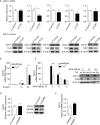Inhibition of murine herpesvirus-68 replication by IFN-gamma in macrophages is counteracted by the induction of SOCS1 expression
- PMID: 30075008
- PMCID: PMC6093694
- DOI: 10.1371/journal.ppat.1007202
Inhibition of murine herpesvirus-68 replication by IFN-gamma in macrophages is counteracted by the induction of SOCS1 expression
Abstract
Gamma interferon (IFN-γ) is known to negatively regulate murine gammaherpesvirus-68 (MHV-68 or γHV-68) replication. This process involves the suppression of the viral gene replication and transcription activator (RTA) promoter, as well as activation of signal transducers and activators of transcription (STAT1). Notably, this effect is gradually attenuated during MHV-68 infection of bone marrow-derived macrophages (BMMs), which raised the possibility that the virus may utilize a mechanism that counteracts the antiviral effect of IFN-γ. By identifying the cellular factors that negatively regulate JAK-STAT1 signaling, we revealed that the infection of BMMs by MHV-68 induces the expression of suppressor of cytokine signaling 1 (SOCS1) and that depletion of SOCS1 restores the inhibitory effect of IFN-γ on virus replication. Moreover, we demonstrated that the expression of SOCS1 was induced as a result of the Toll-like receptor 3 (TLR3) mediated activation of the NF-κB signaling cascade. In conclusion, we report that TLR3-TRAF-NF-κB signaling pathway play a role in the induction of SOCS1 that counteracts the antiviral effect of IFN-γ during MHV-68 infection. This process is cell type-specific: it is functional in macrophages, but not in epithelial cells or fibroblasts. Our study reveals a mechanism that balances the immune responses and the escape of a gamma-herpesvirus in some antigen-presenting cells.
Conflict of interest statement
The authors have declared that no competing interests exist.
Figures







Similar articles
-
The Coronavirus Transmissible Gastroenteritis Virus Evades the Type I Interferon Response through IRE1α-Mediated Manipulation of the MicroRNA miR-30a-5p/SOCS1/3 Axis.J Virol. 2018 Oct 29;92(22):e00728-18. doi: 10.1128/JVI.00728-18. Print 2018 Nov 15. J Virol. 2018. PMID: 30185587 Free PMC article.
-
Murine gammaherpesvirus 68 encoding open reading frame 11 targets TANK binding kinase 1 to negatively regulate the host type I interferon response.J Virol. 2014 Jun;88(12):6832-46. doi: 10.1128/JVI.03460-13. Epub 2014 Apr 2. J Virol. 2014. PMID: 24696485 Free PMC article.
-
Murine cytomegalovirus infection of mouse macrophages stimulates early expression of suppressor of cytokine signaling (SOCS)1 and SOCS3.PLoS One. 2017 Feb 9;12(2):e0171812. doi: 10.1371/journal.pone.0171812. eCollection 2017. PLoS One. 2017. PMID: 28182772 Free PMC article.
-
Murine herpesvirus pathogenesis: a model for the analysis of molecular mechanisms of human gamma herpesvirus infections.Acta Microbiol Immunol Hung. 2005;52(1):41-71. doi: 10.1556/AMicr.52.2005.1.2. Acta Microbiol Immunol Hung. 2005. PMID: 15957234 Review.
-
Natural history of murine gamma-herpesvirus infection.Philos Trans R Soc Lond B Biol Sci. 2001 Apr 29;356(1408):569-79. doi: 10.1098/rstb.2000.0779. Philos Trans R Soc Lond B Biol Sci. 2001. PMID: 11313012 Free PMC article. Review.
Cited by
-
Yellow Fever Virus Down-Regulates mRNA Expression of SOCS1 in the Initial Phase of Infection in Human Cell Lines.Viruses. 2020 Jul 25;12(8):802. doi: 10.3390/v12080802. Viruses. 2020. PMID: 32722523 Free PMC article.
-
ORF3a Protein of Severe Acute Respiratory Syndrome Coronavirus 2 Inhibits Interferon-Activated Janus Kinase/Signal Transducer and Activator of Transcription Signaling via Elevating Suppressor of Cytokine Signaling 1.Front Microbiol. 2021 Sep 28;12:752597. doi: 10.3389/fmicb.2021.752597. eCollection 2021. Front Microbiol. 2021. PMID: 34650546 Free PMC article.
-
hMSCs treatment attenuates murine herpesvirus-68 (MHV-68) pneumonia through altering innate immune response via ROS/NLRP3 signaling pathway.Mol Biomed. 2023 Sep 14;4(1):27. doi: 10.1186/s43556-023-00137-z. Mol Biomed. 2023. PMID: 37704783 Free PMC article.
-
SOCS and Herpesviruses, With Emphasis on Cytomegalovirus Retinitis.Front Immunol. 2019 Apr 11;10:732. doi: 10.3389/fimmu.2019.00732. eCollection 2019. Front Immunol. 2019. PMID: 31031749 Free PMC article. Review.
-
Imbalance of the intestinal virome and altered viral-bacterial interactions caused by a conditional deletion of the vitamin D receptor.Gut Microbes. 2021 Jan-Dec;13(1):1957408. doi: 10.1080/19490976.2021.1957408. Gut Microbes. 2021. PMID: 34375154 Free PMC article.
References
-
- Efstathiou S, Ho YM, Hall S, Styles CJ, Scott SD, et al. (1990) Murine herpesvirus 68 is genetically related to the gammaherpesviruses Epstein-Barr virus and herpesvirus saimiri. J Gen Virol 71 (Pt 6): 1365–1372. - PubMed
Publication types
MeSH terms
Substances
Grants and funding
LinkOut - more resources
Full Text Sources
Other Literature Sources
Research Materials
Miscellaneous

